The major hole left behind in Puerto Rico
The loss of the iconic Arecibo Telescope is a massive blow — but not in the way you may think
Daniel Leonard • February 28, 2023
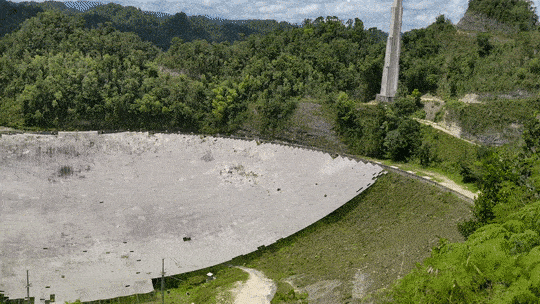
Puerto Rico’s famous Arecibo Telescope collapsed in December 2020. In October 2022, the National Science Foundation announced that it would not be rebuilt. [Credit: Daniel Leonard]
Christiano Brum was there when it collapsed.
“It sounded like a train passing. And then rocks from that tower,” Brum said, pointing up a nearby hill, “started to come this way like a shower. I heard ‘brrr,’ and then little rocks hitting my roof here.”
We were standing in the humid, hilly forest of northwestern Puerto Rico, a couple hundred yards from the rim of the now-defunct Arecibo Telescope. Brum is an atmospheric scientist and the deputy director of science operations at the Arecibo Observatory. He hails from Brazil and has worked at the observatory for more than a decade.
As rocks fell on the roof of the shed where Brum was working, he quickly ducked into the larger research building nearby and checked that all on-site staffers were safe. Luckily, they were. (Though a nearby car got pretty banged up by the falling debris, Brum said.)
That was around 8 a.m. on Dec. 1, 2020. That morning, a failure of support cables — following two lesser cable breaks in the months prior — caused the Arecibo Telescope’s 900-ton receiver platform to come crashing down upon its iconic 1,000-foot-diameter dish. A large swath of the dish was destroyed, as were the upper portions of the concrete towers that had held the receiver aloft.
A recent analysis by the engineering consulting firm Thornton Tomasetti — commissioned by the National Science Foundation (NSF), which owns and funds the Arecibo Observatory — blamed the collapse on a number of factors that largely amount to “mechanical stress,” exacerbated by natural disasters like Hurricane Maria in 2017 and earthquakes in early 2020. Thanks to many years of strain — and one final calamitous collapse — what had once been the world’s largest single-dish telescope became a shattered heap.
In October 2022, the NSF announced that it would not fund the reconstruction of the Arecibo Telescope, nor offer operational funding for the observatory’s other research instruments — like its 39-foot-diameter radio telescope or its LIDAR facility that studies the atmosphere using lasers. Instead, the NSF will allocate $5 million over five years for a new science education and outreach center at the site.
Following this announcement, many might assume that the biggest blow to science was the loss of a highly sensitive radio telescope — a massive structure capable of detecting the universe’s faint radio signals. This would be a mistake. In many ways, Arecibo’s radio capabilities were outclassed by other telescopes years before its collapse in 2020.
The true blow to science came from the Arecibo Telescope’s other, lesser-known capability: radar astronomy. While radio telescopes are common, radar telescopes are rare — and Arecibo was arguably the world’s best source of radar data on objects within the solar system.
And the final loss was not a scientific one at all, but a cultural one. Arecibo played a tremendous role in getting people engaged with science. For young Puerto Ricans in particular, it showed that cutting-edge research could be performed right in their backyard.
With the NSF’s confirmation that it will not be rebuilt, it’s worthwhile to look back on the Arecibo Telescope’s legacy to better understand the two gaping holes — in radar astronomy and Puerto Rican pride — that its loss leaves behind.
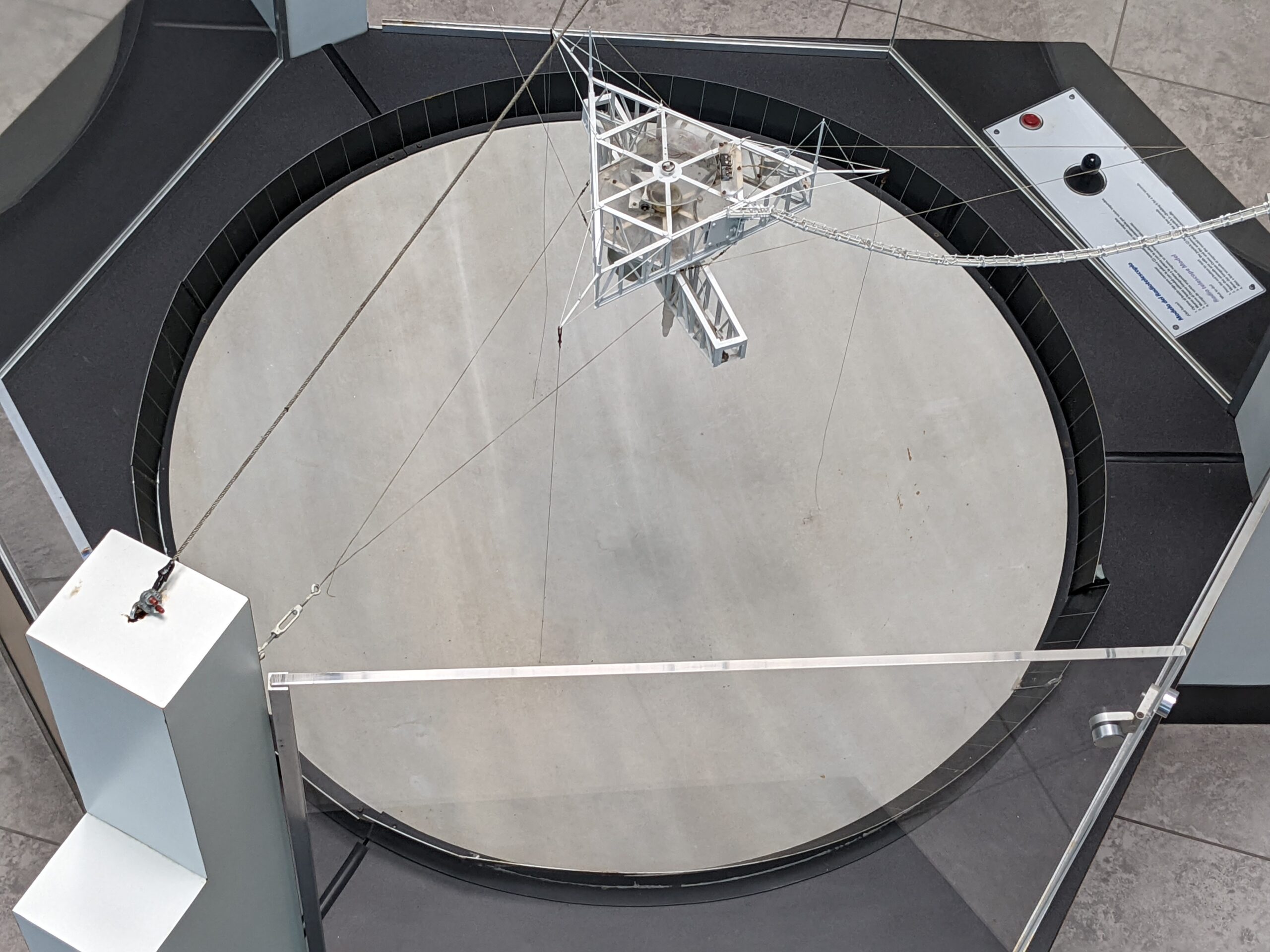
This scale model of the Arecibo Telescope sits in the observatory’s visitor center. The real telescope’s receiver platform — the suspended, triangular structure — weighed 900 tons and came crashing onto the dish on Dec. 1, 2020. [Credit: Daniel Leonard]
Construction on the Arecibo Telescope began in 1960 and finished in 1963. Bill Gordon, an astronomer at Cornell University, oversaw the telescope’s design. He convinced the U.S. Department of Defense that funding an observatory to study Earth’s upper atmosphere would be supremely useful in preparing better anti-ballistic missile defense systems.
Why was northwest Puerto Rico chosen to host the telescope? Different sources offer different explanations: for its natural sinkholes that could accommodate a massive telescope dish; for its proximity to the equator offering a greater range of potential targets in the night sky; or for its location on land that the U.S. government could acquire on the cheap. (The observatory was built on a former tobacco farm.)
Besides performing atmospheric research for the government, the scientists at the forefront of the Arecibo Observatory wanted the 1,000-foot telescope to be supremely useful to the astronomy community. To that end, the telescope was outfitted with two powerful research capabilities: radio and radar.
Radio astronomy involves using a large dish (or an array of smaller dishes working in conjunction) to collect and focus signals from outer space belonging to the long-wavelength portion of the electromagnetic spectrum. Scientists can gather radio waves from a variety of celestial objects, from individual stars to entire galaxies, in order to study their behavior and composition.
Radar astronomy, on the other hand, is less common. Rather than passively receiving light waves from space, radar astronomers beam out their own signals to specific target objects within the solar system, then gather those same signals as they bounce back to Earth. Studying the pattern of the waves that return can inform researchers about the shapes and surface features of the objects they choose to target.
Arecibo’s contributions to radio astronomy are what made the telescope famous. Throughout its career, for example, the Arecibo Observatory notably contributed to the search for extraterrestrial intelligence, or SETI. While there are plenty of natural sources of radio emissions in the night sky, scientists have wondered whether some of these radio sources might be unnatural. Maybe an alien civilization — perhaps one still in existence or perhaps long extinct — has been transmitting radio waves into space, and a telescope would allow us to receive their messages.
Andrew Siemion, the director of Berkeley’s SETI Research Center, said that for the SETI community, Arecibo was “the most important telescope that we have ever used.” When looking for faint radio signals, Siemion says the size of the collecting area is generally the key feature, so the giant Arecibo Telescope was a natural standout. The Arecibo Telescope contributed to a variety of SETI surveys over its decades-long service. Plus, it sent out a radio broadcast of its own: the famous “Arecibo message” of 1974, composed by astronomer and SETI pioneer Frank Drake, who designed it to (potentially) be intelligible to alien lifeforms.
Besides helping with SETI, the Arecibo Telescope’s radio observations were used to discover the first known exoplanets, which revolve around stars outside our own solar system. In 1992, astronomers Aleksander Wolszczan and Dale A. Frail announced that data they had collected using the Arecibo Telescope showed a slight irregularity in the radio pulses emitted by a rapidly-spinning neutron star, indicating at least two super-Earth-sized planets orbiting the star. The following year, the Nobel Prize in physics was awarded to two others who used the Arecibo Telescope to identify the first known binary pulsar — “a discovery that has opened up new possibilities for the study of gravitation,” in the words of the Nobel Committee.
These were major contributions, no doubt about it. But, after the turn of the 21st century, Arecibo’s relevance to the radio astronomy research community began to fade.
“Since 2005, maybe even a little bit before that, there has been a move in radio astronomy toward multi-element telescopes,” says Siemion, referring to arrays of smaller radio telescopes working in conjunction instead of singular, massive-dish radio telescopes working alone. These arrays, set up in places like the flat plains of New Mexico and Chile’s Atacama Desert, are generally easier to build, maintain and upgrade than massive single dishes like Arecibo’s. They’re also arguably more useful: The dishes in these multi-element arrays can be repositioned to focus on various points of interest in the night sky. While Arecibo’s cable-suspended receiver platform was able to pivot a bit, giving the telescope a slightly larger range of view, the dish itself was entirely immobile — stuck in its sinkhole, staring straight up.
The two men who discovered the first exoplanets had similar reactions to the NSF’s decision not to rebuild the Arecibo Telescope. Wolszczan called it “very sad, but predictable;” Frail said it was “a bit disappointing,” but noted that it was extraordinary for a radio telescope to be used for so long in the first place.
In its final decade, the Arecibo Telescope just wasn’t a cutting-edge source of radio data when compared with the alternatives. It even lost the title of “world’s biggest single-dish radio telescope” to a 1,640-foot-diameter Chinese competitor in 2016.
As the Arecibo Telescope’s influence over radio astronomy declined in its later years, its operating budget declined with it. In 2017, for example, the NSF announced plans to decrease its contribution to the site from around $8 million per year to just $2 million per year. (The NSF did later find a partner — the University of Central Florida — to help cover the observatory’s remaining expenses.)
But radio astronomy is just one piece of the story. While radio telescopes are fairly common, the Arecibo Telescope had a much rarer ability: radar astronomy.
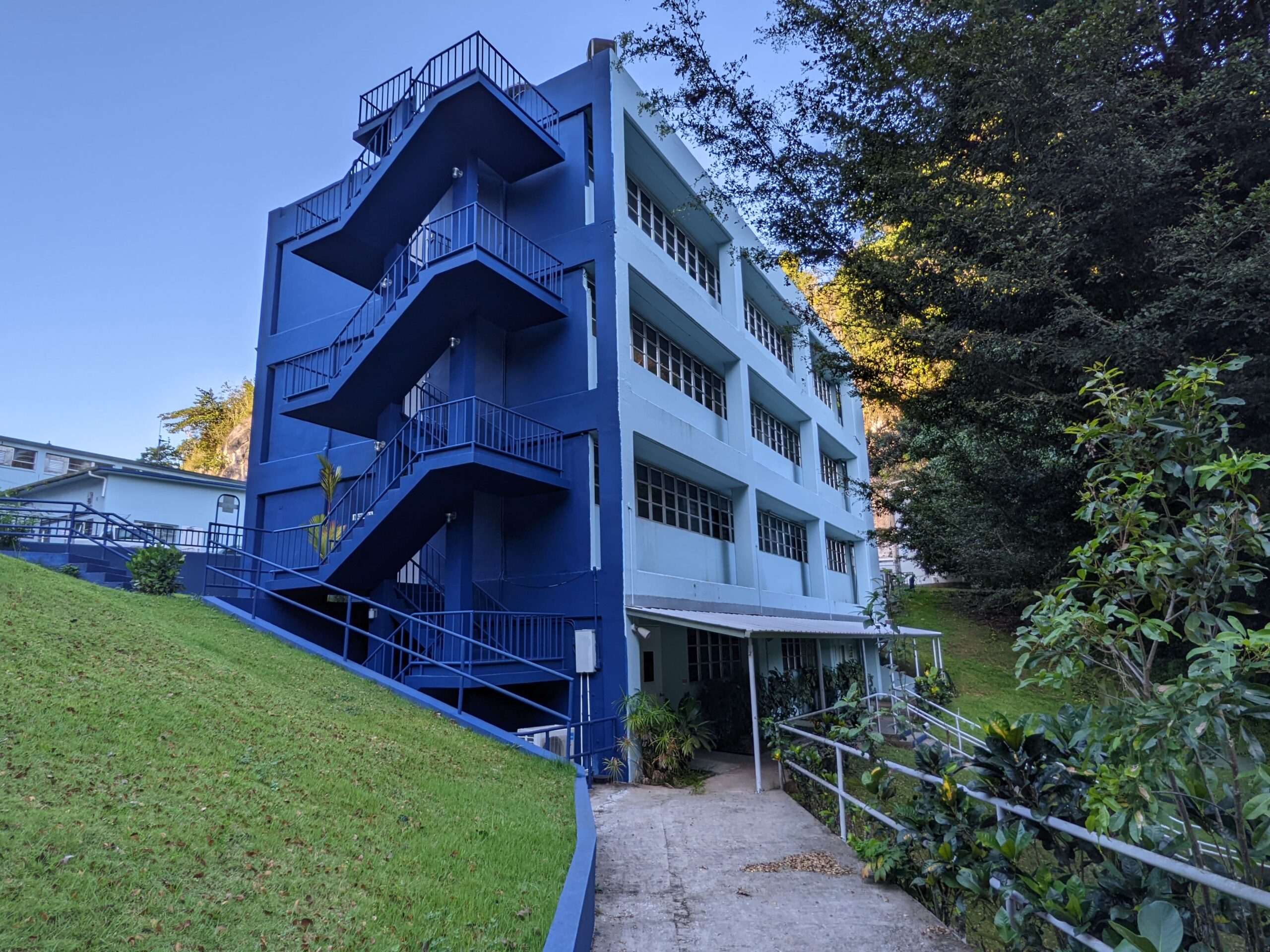
While data from the Arecibo Telescope has been used by astronomers across the globe, this four-story building houses the observatory’s on-site scientists. [Credit: Daniel Leonard]
Radar astronomy is a lot more active than radio. Rather than waiting for signals from deep space to come to you, radar telescopes transmit their own signals to celestial bodies they want to study. Those signals bounce off the object, then travel back to Earth, where the same telescope (or a partner institution) can catch them on their return.
Studying that bounce-back data can tell you a lot about the object in question, such as its shape or size, which can be hard for optical telescopes to determine with accuracy. However, it isn’t feasible to send these signals out to very distant objects, so radar astronomy is limited to targets within our solar system.
Leading up to its collapse, research at the Arecibo Observatory had coalesced into three areas: astronomy, atmospheric sciences and planetary sciences. Astronomy was based around radio observations, but radar was integral to the other two.
Christiano Brum leads the atmospheric sciences team. In its early years, atmospheric research had been Arecibo’s top priority. But, today, this tends to take a back seat to the observatory’s space research — at least in terms of what the public cares about and what the visitor center highlights. Brum doesn’t seem to mind; it’s clear that he, at least, considers atmospheric research exciting.
The planetary science team — which studies objects in the solar system — has no problem getting the public excited, on the other hand. This team investigates objects that the public is fascinated by: potential planet-killing asteroids. The Arecibo Observatory was a key partner in NASA’s multi-institution “planetary defense” program, helping provide radar data about many near-Earth asteroids that may or may not (almost always “may not”) pose a risk to Earth.
For example, the Arecibo Telescope provided radar data that helped NASA plan out its recent Double Asteroid Redirection Test (DART), says Andy Rivkin, a planetary astronomer at Johns Hopkins University who helped lead the mission. Optical telescopes can’t get a good look at small, distant objects. But with radar, astronomers could determine the precise size and shape of Didymos and its moonlet Dimorphos, which helped them successfully crash a spacecraft into Dimorphos and alter its orbit in September 2022.
“Arecibo was absolutely still producing important data for asteroid science at the time of its collapse, and there is no replacement for its specific capabilities for high-resolution radar studies,” says Rivkin.
Flaviane Venditti leads the planetary science team at the Arecibo Observatory. Like Brum, she’s Brazilian, and she works on the fourth floor of the dark- and light-blue office building that houses Arecibo’s on-site research scientists. In addition to DART, “Arecibo data has supported many missions — to help plan, select the target and characterize the target,” Venditti says. Space missions are expensive, so “you don’t want to send a spacecraft to an object if you have no idea about its qualities.”
Without the Arecibo Telescope, Venditti worries that there will be plenty of new asteroids identified, but no facility with the capability to study their precise characteristics. Often, there’s a lot of uncertainty about the orbits of newly discovered asteroids, she says, and space agencies like NASA add these rocks to a “risk list.” Using radar, Arecibo has been able to study these asteroids closely, reducing the uncertainties. Doing so generally reveals that they pose no threat to Earth — allowing humanity to breathe a collective sigh of relief.
Venditti’s planetary science team hails from around the world: Luisa Fernanda Zambrano-Marin is from Columbia, Sean Marshall from the U.S. and Maxime Devogèle from Belgium. Each of these researchers highlighted the importance — and excitement — of planetary defense work. The exact wording of the group’s motto changes depending on whom you ask, but it’s always along the lines of “Remember the dinosaurs,” or “The dinosaurs didn’t have a space program.” A small plastic dinosaur sat on the control panel in the research instruments’ command center.
Even after the collapse, the planetary science team kept working through the Arecibo Telescope’s backlog of unanalyzed data to gain new insights about asteroids. From beyond the grave, the Arecibo Telescope continues to help protect the Earth.
However, radar studies do have some limitations. Because radar is highly precise, you can only really point it at something if you already know it’s there. In other words, radar wasn’t helping Arecibo to sweep the sky in search of new asteroids, just to pin down the characteristics (sizes, shapes, and precise orbits) of ones that had already been found. Still, the Arecibo Observatory’s planetary scientists emphasized that this information could be key for planning out a defense or redirection mission (à la DART) should humanity ever need it.
With the Arecibo Telescope gone, there is only one comparable radar astronomy facility in the world: the Goldstone Solar System Radar in California. Lance Benner, a scientist at NASA’s Jet Propulsion Laboratory, helps lead Goldstone’s radar observations. He explains that Goldstone has a broader range of view over the night sky than Arecibo did. However, Arecibo’s sensitivity allowed it to study asteroids twice as far away as what Goldstone could observe.
“Arecibo was a phenomenal facility,” Benner says. “It was a significant loss for the whole world when it collapsed. It was a very sensitive, very capable instrument.” Now, there’s no extant radar telescope that can observe objects as deep in space as Arecibo could. Other radar facilities are under development, Benner says, but they’re rare; radar transmitters are expensive and require massive power input, he explains.
“NASA and NSF are jointly pursuing a study to see what the radar needs are for the next generation,” an NSF spokesperson said in an email. The NSF would “review current radar infrastructure to determine how to best meet the community’s needs, including expanding capabilities at existing facilities to replace those lost at [Arecibo].”
So, while the loss of a radio telescope wasn’t a massive blow to the scientific community, the loss of Arecibo’s radar capability certainly was.
And, in addition to radio and radar, the Arecibo Telescope had a completely different dimension — one that was largely independent from its success or failure as a scientific research instrument. This was its function as a cultural icon: a source of Puerto Rican pride, and a tool for getting people excited about science.
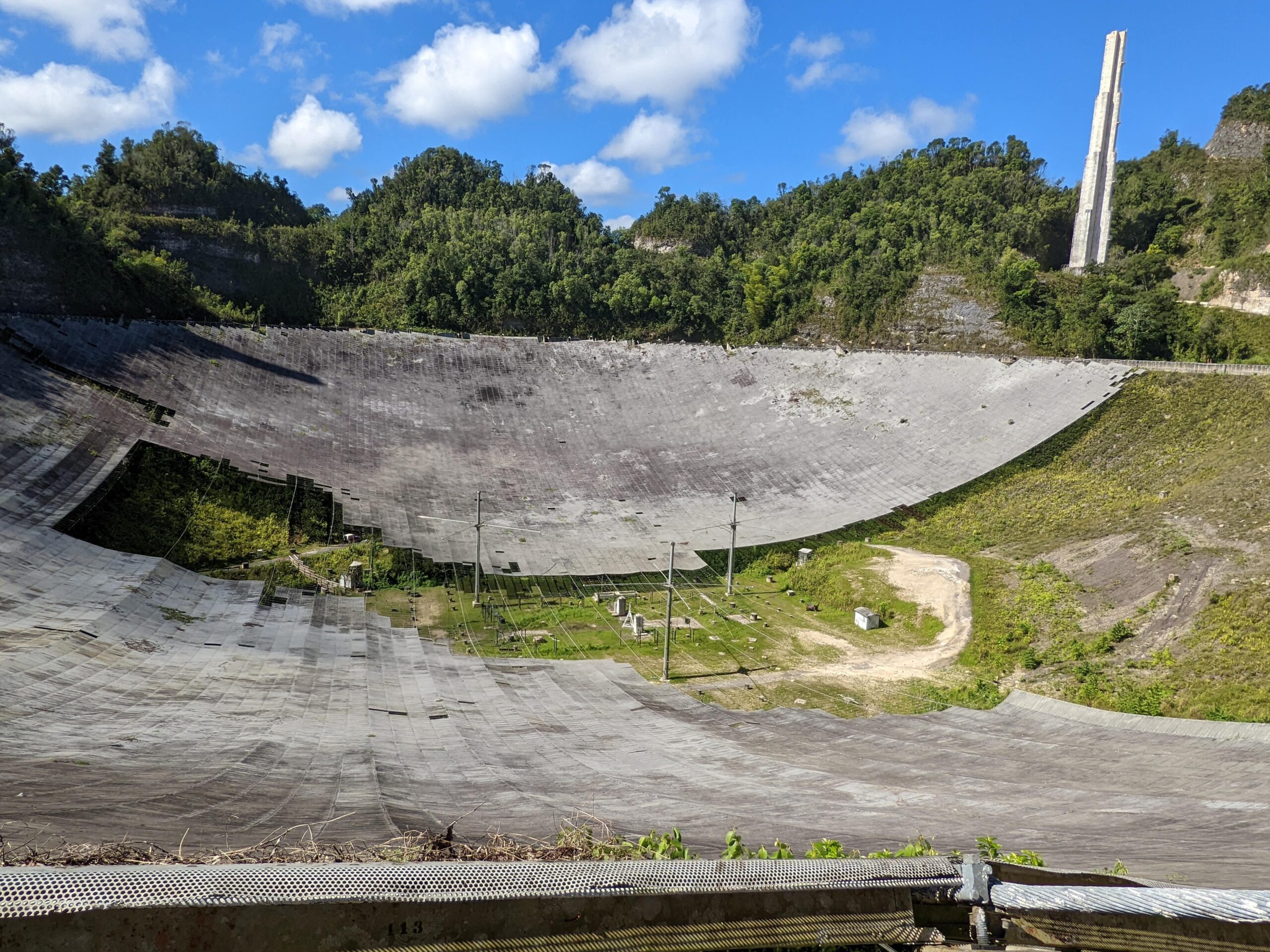
Over a third of the Arecibo Telescope’s 1,000-foot-diameter dish was dismantled in the months following its collapse. The cleanup cost an estimated $30 to $50 million. [Credit: Daniel Leonard]
If “Jeopardy” ever asked, “This decade was the zenith of the Arecibo Telescope’s pop culture relevance,” the natural response would be: “What are the 1990s?”
In 1995, the Arecibo Telescope served as backdrop for the climax of the James Bond film “GoldenEye.” In the film, a Russian crime syndicate uses the telescope to send commands to the titular GoldenEye satellite — an electromagnetic weapon with the potential to devastate Britain’s economy. The film’s closing act sees Pierce Brosnan slide down the dish of the Arecibo Telescope to escape gunmen, then later climb up to its suspended platform, dropping his nemesis onto the dish below with a thud.
Two years later, the Arecibo Telescope was featured in “Contact,” a film adapted from a book by Carl Sagan about a SETI researcher — played by Jodie Foster in the film — who makes contact with aliens. This film left a big impact on many viewers, including a young Flaviane Venditti.
“Since I was a teenager, that has always been my favorite movie,” says Venditti, explaining that she and several of her colleagues were partly inspired to go into astronomy thanks to the film. “I think it was a big inspiration, especially for women in science. Women don’t have as many role models in the movies.” While the film helped young Venditti hone her interest in astronomy, she never expected she would end up working for the exact same facility as Jodie Foster’s character.
The Arecibo Observatory has posters for both “GoldenEye” and “Contact” hanging in its visitor center. It’s unclear why the world’s cultural attention converged on Arecibo in the mid-1990s, then turned away just as suddenly — though it might have something to do with the rise and fall of the telescope’s contributions to radio astronomy.
In Puerto Rico, however, the telescope’s legacy persisted.
Many Puerto Ricans view the Arecibo Observatory as a source of pride. While scientists who work at the observatory or rely on its observations hail from across the globe, the observatory’s existence as a research site proves that Puerto Rico can contribute to world-renowned scientific research. Puerto Rican engineers and technicians have been critical to keeping the site’s instruments up and running.
The observatory also plays a key role in inspiring the next generation. According to Abel Méndez, a planetary astrobiologist at the University of Puerto Rico at Arecibo, field trips to the observatory have helped engage Puerto Rican students in science, technology, engineering and math (STEM). Visiting the observatory showed them that astronomy wasn’t something scientists were performing somewhere “out there,” but rather right here at home, Méndez says. Puerto Rico’s existing scientists benefited from that message, too. Méndez says he felt better connected to the global research community by having the observatory nearby. “It’s not only inspiring for people, but also helps to keep them going in the field.”
In addition, northwest Puerto Rico enjoyed a number of economic benefits from the site, Méndez points out: tourism, payments to local utility companies and jobs for the hundred-or-so people needed to run the site, from maintenance workers to technicians to chefs. After the collapse of the Arecibo Telescope, many of these workers were essential to preserving the operations of the Arecibo Observatory’s other research instruments, like its smaller 39-foot radio telescope; its solar spectrometer, which monitors the behavior of the sun; and its LIDAR facility, which uses lasers to probe the atmosphere.
The NSF’s October decision to cut the Arecibo Observatory’s research funding means most of the site’s workers will likely be laid off, Méndez says. The facility’s staff scientists will probably lose their positions, too.
“NSF is grateful to current and past employees of the Arecibo Observatory, who have been integral to the outstanding work at the site,” an NSF spokesperson said in an email. “NSF recognizes the scientific, educational, historic, cultural, and economic significance of the Arecibo Observatory site to Puerto Rico and the global scientific community and is focusing on leveraging the incredible STEM educational potential of the facility,” the spokesperson added.
To do that leveraging, the NSF has announced a plan to grant $5 million over five years to a university, consortium, or other group that can establish a new outreach center to “promote STEM education, learning, and teaching” for the Puerto Rican community. Yet, even if this budget is enough to cover all of the center’s operations — and Méndez and others have their doubts — cutting funds to the Arecibo Observatory’s research operations might hinder the success of its outreach efforts.
Consider the observatory’s current Angel Ramos Foundation Science & Visitor Center, which relies on funding from donations and ticket sales. The visitor center offers a small museum about astronomy, a terrace overlooking the (now semi-dismantled) Arecibo Telescope dish, and it runs outreach programs aimed at getting local students — especially girls — engaged in science.
This visitor center had to shut down its operations at the beginning of the COVID pandemic, followed by a much longer closure after the telescope’s collapse. It didn’t open again until March 2022, and since then, ticket sales have plummeted. “A lot of people still think we’re closed,” says Yasmin Santiago, who works at the visitor center. “They don’t know that the visitor center is open again, and that research is still going on here, because the media hasn’t covered it.”
The loss of the Arecibo Telescope sent a huge blow to the Arecibo Observatory’s visitorship. If all of the observatory’s other research instruments fall into disuse from being defunded, it may have a similar impact.
An outreach center funded by the NSF may not have to worry about ticket sales, but it still might encounter the same foot traffic problem as the current visitor center. That is, it’s unclear how many people will be willing to make the trek — a winding, 30-minute drive into the hills south of the small coastal city of Arecibo — to an observatory without active research instruments. It’s also unclear how the new NSF-funded center will incorporate the existing visitor center, if at all.
To many Puerto Ricans, as Méndez highlights, the draw of the Arecibo Observatory was the notion that Puerto Rico was contributing to cutting-edge scientific research. With the NSF cutting all funding to the Arecibo Observatory’s research instruments, it’s likely that the feeling of inclusion in the global research community will begin to fade, no matter how many outreach programs the new NSF-funded center is able to run on its $5 million budget.
It seems that the once-mighty Arecibo Telescope has completed its Ozymandian transition; no longer a research tool, it now sits as a historical marker of a bygone age. According to the NSF spokesperson, “As much of the dish and towers that could be stabilized were retained to preserve the outstanding historic legacy of the telescope. There are currently no plans to dismantle those remains.”
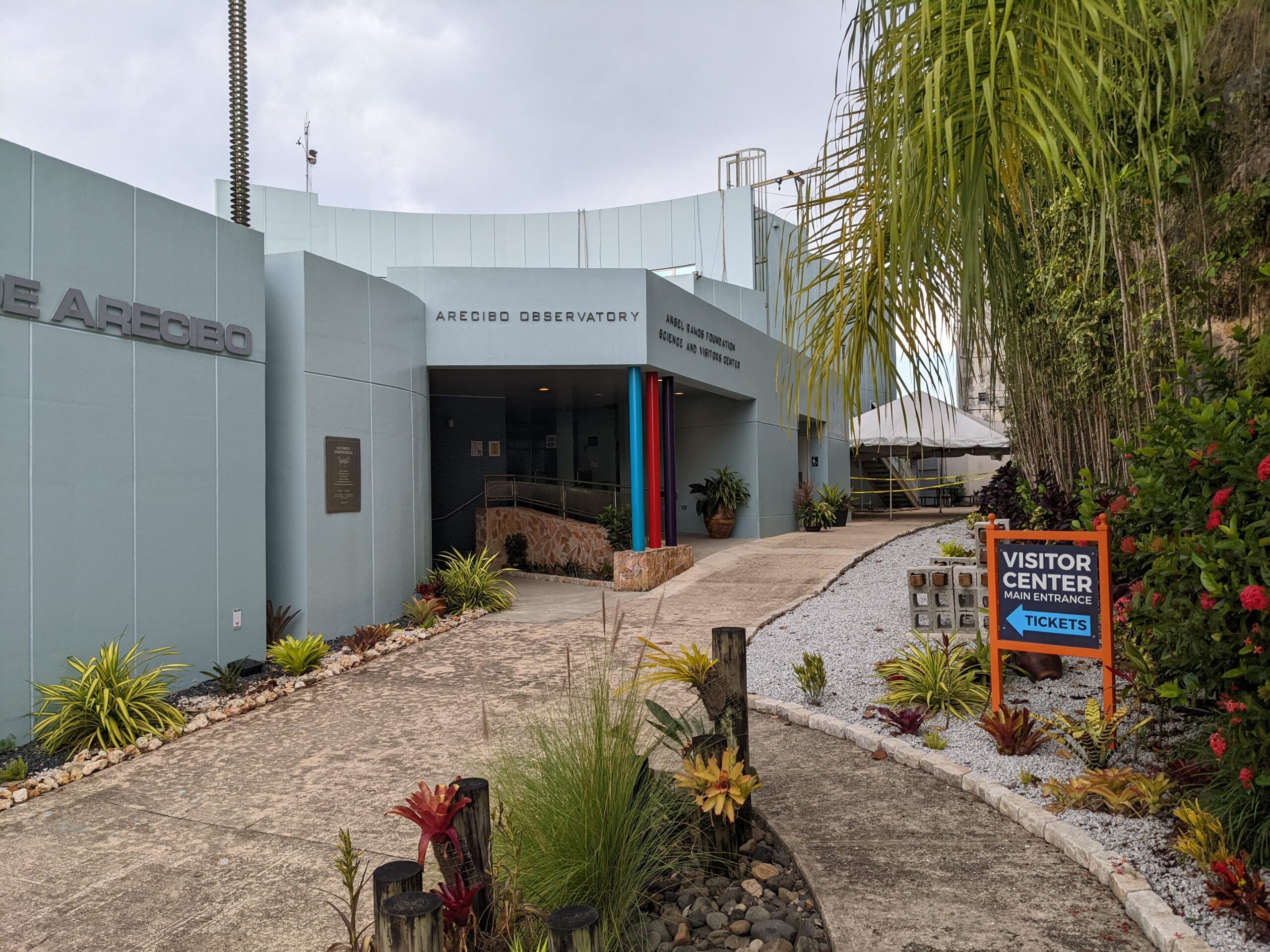
Visitorship to the Arecibo Observatory’s visitor center has decreased since the telescope collapsed. The future of this existing center is uncertain under the NSF’s plan to fund a new center for STEM education. [Credit: Daniel Leonard]
After telling me about his research and what it was like to be at the observatory during the collapse, Christiano Brum asked me if I wanted to walk down to see the remains of the Arecibo Telescope. Naturally, I agreed.
We shuffled down a path strewn with gravel and larger rocks. Along the way, the occasional tiny lizard darted away from us, and we could hear faint calls from Puerto Rico’s heard-but-not-seen coqui frogs. (The chorus — “coqui, coqui” — gets much louder at night.)
As we emerged on the edge of the sinkhole, I gazed down and out at the dish — my first glimpse of it outside of the movies. Although over a third of it had been dismantled, and it was missing the massive platform that used to be suspended above it, the dish was still overwhelmingly majestic in its size. Like the (far-larger) Grand Canyon, it inspired a kind of awe outside the typical realm of experience.
Brum told me that I could go down beneath the dish, but only with a hardhat, per the rules. But the hat didn’t seem to be very useful; anything immediately dangerous had already been removed or fallen off.
Up close, it became clear that the dish was not a singular structure as I had assumed from pictures, but rather an array of thousands of perforated aluminum panels. The perforations were too small for radio signals to slip through, but big enough to let in sunlight; beneath the dish, vegetation grew thick. For 57 years, this gigantic sieve helped us capture the cosmos.
On the way out from the sinkhole, I noticed a roadside sign that I had missed earlier. It warned of “Radiation Danger.” It was topped by a red light bulb that presumably lit up whenever the telescope was in use. The bulb was dark as I passed it. It seems it will be dark for good.
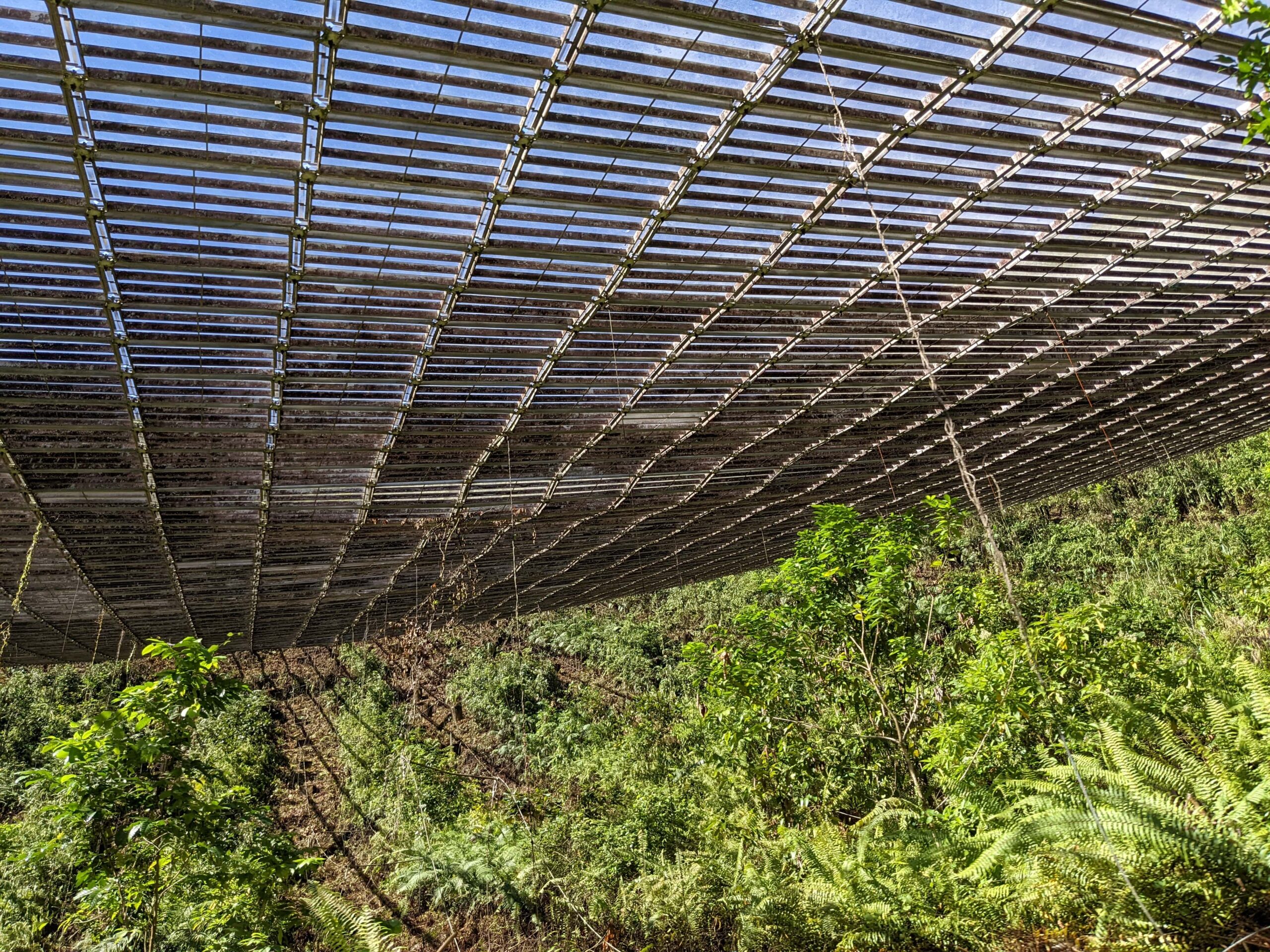
Sunlight shines through the remains of the Arecibo Telescope dish. [Credit: Daniel Leonard]
The reporting for this article was partially supported by a grant from the National Science Foundation.
10 Comments
You failed to mention that the AO had the most powerful transmitter in the world. The S Band panetary radar. 1MW CW. Nothing could touch it. The ionospheric radar was 2.5MW but was pulsed. Only about 100KW radiated. Too bad Christian didnt show you the ionospheric radar. It is very Frankensteinish.
Some rich Puerto Ricans,like Jo and mark anthony can easily finance the rebuilding of the entire project and be a tax write off
Good note. I live in the isle. I never had read this much of it but I skim the report.
As a Puerto Rican living in New York I am devastated upon reading this news. The telescope was the greatest attraction on our tiny island. That it contributed so much is sad that NSF has chosen not to rebuild will impact Puerto Rico s tourism. I was fortunate to have seen it in my lifetime. It was for a very long time usefull to the U.S. but like all things U.S. it broke throw it away. We are living with the disposable generation who doesn’t bother to fix just replace. How sad for us older generations we are becoming the lost and forgotten dinosaurs . Shame shame shame on you NSF you let go of another great one.
It was very impressive in person vist. To bad for this accident keeping the ears of the world deaf. Should be repaired the only on left is in china which a larger disk but working .
Outstanding article providing important information about the significance of the Arecibo Observatory, fields of current & prior scientific research conducted and impact of NSF funding cuts, especially for educational outreach in STEM fields for young people as well as cultural significance for Puerto Rico !
Great article about the significance of the Arecibo Observatory. It is amazing how much knowledge of our universe this facility discovered. We will miss it.
Thank you ♀️ for telling our story. Marielly Morales, Ponceña living in Colorado. ❤️ Viva Puerto Rico ❣️
The AO was so important to many aerospace scientist in the world. My hope is that they make it known. Radar technology is important also. Nice article. You made it more personal then other articles I’ve read about the AO.
As a regular person, it amazes me that super smart people use something that hadn’t been maintained properly for so many years. Corrosion of the cables, known damage and cable breaks, and tower maintenance could’ve prevented this but it was not done. Reminds me of the Space Shuttle flights when space walks would have made details of launch damage exact.